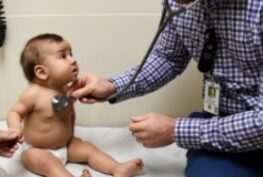Asylum seekers could be bringing infectious diseases across our southern border. When they are bussed to New York and elsewhere, these diseases go with them.
In 1903, my grandfather Alex entered the United States from Bialystok, Poland, following a pogrom that saw his parents killed. Once in the United States, he did not enter right away, despite a brother who was already here. Instead, he first waited at Ellis Island in New York Harbor, not just to be processed but also so that he could be screened for tuberculosis as well as other contagious diseases.
Admittedly, screening methods were ineffective back then compared with now, but immigrants knew that it was part of gaining admission to this land of promise, land of sanctuary.
120 years later, I was out on the street in front of my office recently when I saw a man lying in the hundred degree heat barely moving. I examined him with my stethoscope and found that he was still breathing. I called 911 and the ambulance took him to the hospital where I had trained, Bellevue, which proudly takes all comers. The ambulance attendants said they thought the man was a migrant who had crossed the border from Mexico, and without being detained had been bussed to New York City, where he had nowhere to go but the street.
Mayor Eric Adams, who was initially welcoming in our status of sanctuary city, is now expressing alarm as about 100,000 asylum seekers have come to New York City since spring 2022. Our shelters are full, and there are few other places for them to go than the streets and the summer heat.
Adams is making a major plea to the state and Gov. Kathy Hochul, but so far not nearly enough has been done. A public health emergency for the city is a public health emergency for the state and for the country as well. USA TODAY just reported “plans to use $25 million in state funds to rent temporary homes for up to 1,250 asylum-seeking families who opt to leave New York City’s crowded shelters.” But this is just a drop in the bucket.
Last week I also visited migrants, including many children who looked at me with sad, expectant eyes, camped outside the Roosevelt Hotel here in Manhattan, without proper means to wash or toilet or without guaranteed hydration.
They were immediately at risk for dehydration and dysentery. I offered them my medical services, but they proudly refused.
Migrants could be bringing infectious diseases across our southern border. When they are bussed to New York and elsewhere, these diseases go with them. A recent study showed that more than 4% percent of migrants from Central and South America to Europe were sick with Chagas’ disease. It’s contagious without the help of an animal or a blood-sucking bug and can cause serious complications, including heart failure.
Tuberculosis is on the rise in this country, as is syphilis and other sexually transmitted infections.
The Centers for Disease Control and Prevention reports that immigration applicants with communicable diseases are inadmissible to the United States, but they can’t be stopped if they aren’t routinely screened before entering the country, as is the case with undocumented migrants.
Neha Jaggi Sood, a spokesperson at the Division of Global Migration and Quarantine at the CDC, told me that though the CDC has ”comprehensive systems to track communicable diseases,” they do not “track diseases by immigration status.”
Sood added that “underreporting might occur.”
Dr. James Hodges, an internist practicing at the Texas border, told me that in his experience, the “open border” is leading to more drug-resistant tuberculosis in the United States because patients are only partly treated by over-the-counter antibiotics available in Mexico.
In southern Arizona, Pinal County Sheriff Mark Lamb told me, “Border Patrol and local agencies have seen all types of diseases like tuberculosis, scabies, COVID, hepatitis A and B, gonorrhea, syphilis, mumps, chicken pox, dengue fever, etc. When the discussion was hot and heavy about Title 42 (a law that allows denial of entry to limit the spread of a disease) going away, I would consistently say it wasn’t just about COVID; it was about all the other health hazards being brought across our borders.”
Dr. Paul Offit, head of the Vaccine Education Center at the Children’s Hospital of Philadelphia, told me in a radio interview recently that it is measles that keeps him up at night. With measles vaccination rates dropping, and not all undocumented migrants are screened for measles before entry, he might well be right.
Measles and other vaccines are offered to eligible U.S.-bound migrants and refugees, but there’s no enforcement in place yet.
The health risk extends wherever the migrants are sent, including here in New York City. The porous border is not just a national security crisis, it is also a public health emergency.
Link to article: https://www.usatoday.com/story/opinion/2023/08/17/new-york-asylum-seekers-public-health-crisis/70598475007/





No Comments